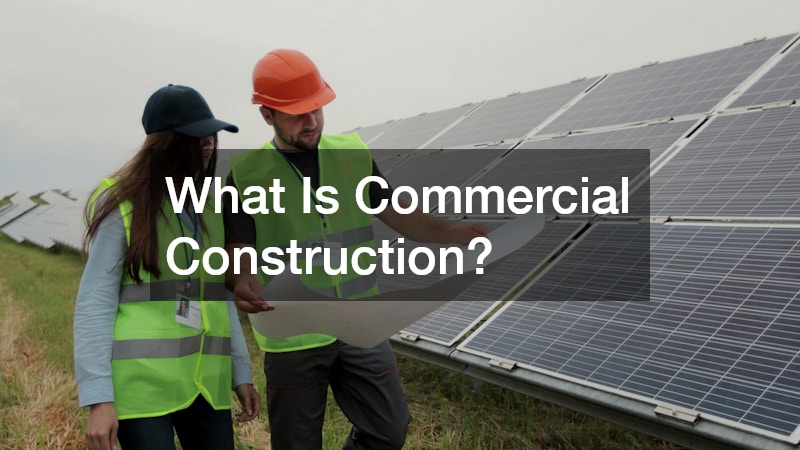In this article, we delve into the world of commercial construction, exploring its definition, significance, and the role it plays in modern development. This guide will address some of the most common questions regarding commercial construction.
What Does Commercial Construction Involve?
Definition and Scope
Commercial construction refers to the building projects that are meant for commercial purposes. This can include a broad range of structures such as offices, warehouses, restaurants, hospitals, and more.
The scope of commercial construction goes beyond mere building; it encompasses architecture, engineering, and project management, ensuring that the structures are fit for business use and comply with relevant industry standards.
The nature of these projects varies significantly from one type to another, with each having specific requirements and regulatory guidelines. For instance, building a hospital requires adhering to stringent health regulations, while constructing a retail space might focus more on customer accessibility and aesthetic appeal. Moreover, the layout, design, and functionality of commercial spaces are determined by the needs they aim to fulfill, making the planning phase critical.
With the rapid advancement of technology, commercial construction has seen integration with modern tools that enhance efficiency and precision. From digital blueprints to sophisticated project management software, the industry has embraced innovation to refine the building processes and facilitate the creation of safe, sustainable, and state-of-the-art commercial environments.
Types of Commercial Construction Projects
Commercial construction is a diverse field that encompasses various types of projects, each serving unique business purposes. Among the most common are office buildings, which vary in size from small local offices to large corporate skyscrapers. These constructions must accommodate workers comfortably while providing the necessary technological infrastructure and adhering to urban design codes.
Retail spaces form another significant segment of commercial construction. These projects might include shopping malls, standalone retail stores, and complex shopping centers. Retail constructions emphasize consumer traffic and layout accessibility, ensuring that the customer experience is seamless from entrance to checkout. Design aesthetics also play a pivotal role, with many retail spaces featuring innovative architectural designs to attract consumers.
Hotels and institutional structures such as schools and hospitals are also critical components of commercial construction. Hotels require specific features for guest comfort and safety, including fire safety systems, sufficient accommodation facilities, and leisure spaces. Meanwhile, institutional buildings demand compliance with industry-specific regulations to support education or healthcare services effectively. Each type poses unique challenges and opportunities within the commercial construction landscape.
Key Players in Commercial Construction
Several key players drive the commercial construction process, each contributing a particular expertise essential to the successful completion of a project. Developers are fundamental as they initiate projects and secure funding. Their role involves coordinating various teams and ensuring all aspects align with the intended business objectives and timelines.
Contractors are central to commercial construction, responsible for overseeing the day-to-day operations and are responsible for the construction site. They manage labor, materials, and schedules, ensuring that the building process stays on track. Their expertise in handling practical building challenges and resource management is pivotal in bringing architectural designs to life.
Architects and engineers are instrumental in the planning stage of construction projects. Architects conceptualize and design the aesthetic and functional aspects of a building, while engineers ensure that these designs are structurally sound. Both must collaborate closely to balance creativity with practicality, creating spaces that are both visually appealing and highly functional.
How Does Commercial Construction Differ from Residential Construction?
Project Scale and Complexity
Commercial construction projects tend to be larger in scale and complexity compared to residential constructions. These projects often involve multiple floors and complex infrastructures, such as HVAC systems, elevators, and specialized electrical systems, to accommodate varied business operations. In contrast, residential projects typically focus on simpler utilities and fewer floors.
The complexities in commercial construction are also reflected in the project timelines and resource requirements. High project scales necessitate detailed planning stages, with numerous stakeholders from various disciplines contributing their expertise. Each step from design to execution involves numerous checks and re-evaluations to minimize risks and ensure the building meets the set standards.
Furthermore, the customization necessary in commercial constructions adds layers to both complexity and the scale of the endeavor. Businesses require spaces tailored to their specific operational needs, which may involve specialized rooms or equipment placements. These tailor-made designs require a higher degree of collaboration and creativity among architects, engineers, and contractors.
Regulatory and Compliance Differences
One of the significant differences between commercial and residential construction lies in regulatory compliance. Commercial construction faces a more extensive array of rules and regulations designed to ensure safety and sustainability. For instance, commercial buildings must adhere to fire safety, accessibility, and zoning regulations more stringently than residential projects.
Building codes for commercial projects are comprehensive and frequently updated to incorporate safety advancements and new environmental standards. This regulatory complexity requires specialized expertise to navigate, often necessitating the involvement of compliance officers or legal experts to ensure all standards are met from a local, state, and federal level.
The catdtherable liability and insuranlevelsplications in commercial construction further emphasize the importance of following compliance measures rigorously. Non-compliance can result in substantial financial penalties and, in severe cases, project shutdowns, underscoring the need for precise documentation and adherence to building codes throughout the construction process.
Financial and Economic Considerations
Commercial construction generally involves substantial financial investments, with projects often requiring significant upfront capital. This scale contrasts with residential construction, where budgets tend to be smaller and more manageable for individual investors. The economic impact of commercial construction is considerable, fueling job creation, local economies, and urban development.
The financial planning for these projects must consider various elements, such as sourcing materials, manpower costs, and technological investments. Securing funding often involves complex financial arrangements with banks, investors, or consortiums to mitigate risks associated withconsortiae capital ventures.
Long-term profitability and sustainability are crucial considerations in commercial construction. The goal is not only to complete a building but to ensure it remains viable as a commercial entity that attracts business and adapts to future needs. Strategic planning and market analysis are vital to achieving these goals, considering how the commercial landscape might evolve and influence the return on investment.
What Are the Latest Trends in Commercial Construction?
Adoption of Technology and Innovation
Innovation is rapidly transforming the commercial construction industry, with technology playing an increasingly pivotal role. The integration of Building Information Modeling (BIM) has revolutionized how projects are planned and managed, allowing for virtual simulations that optimize design and construction processes before physical work begins.
Automation and robotics have started to make significant inroads, particularly in repetitive tasks such as bricklaying and surveying, helping to reduce labor costs and increase precision on construction sites. Drones and 3D printing technologies are also gaining traction, providing cost-effective solutions for site surveys and creating prefabricated components.
Digital transformations extend beyond the construction site; project management software and cloud-based solutions ensure effective communication, real-time updates, and collaboration among stakeholders. These technological advancements are streamlining operations, minimizing delays, and reducing waste, thereby enhancing overall project efficiency and cost-effectiveness.
Sustainability and Green Building Practices
The emphasis on sustainability in commercial construction is growing as businesses become increasingly aware of their environmental responsibilities. Green building practices include the use of recycled materials, energy-efficient systems, and designs that reduce resource consumption to lower carbon footprints.
Commercial construction projects are adopting Leadership in Energy and Environmental Design (LEED) standards to ensure their buildings meet certain sustainability criteria. These standards drive design choices that incorporate renewable energy sources like solar panels and wind turbines, alongside efficient waste management systems and water-conservation strategies.
The marketing advantage of green buildings is notable, with businesses keen to promote their environmental credentials to clients and customers. Projects that prioritize sustainability not only contribute positively to the environment but can also offer economic incentives, such as lower operational costs and potential tax benefits, for investors and developers.
Market Dynamics and Growth Opportunities
The commercial construction market is subject to fluctuating dynamics driven by economic conditions, government policies, and evolving business needs. While sectors like retail and hospitality experienced volatility during economic downturns, others like technology and logistics have seen growth, influencing where and how new commercial buildings are developed.
Urbanization and population growth continue to drive demand for commercial spaces, presenting considerable growth opportunities for construction companies. Emerging markets are witnessing a rise in commercial developments, especially in regions investing heavily in infrastructure and modernization, signifying a lucrative horizon for the industry.
Challenges remain, including labor shortages and rising material costs, compelling companies to seek innovative solutions and strategic partnerships. Staying abreast of these trends is crucial for businesses aiming to capitalize on new opportunities while navigating the competitive and dynamic commercial construction landscape.
As we’ve explored throughout this article, commercial construction is a complex and dynamic field, essential for developing commercial spaces that meet the needs of businesses and communities. Understanding its intricacies can provide valuable insights for stakeholders and participants in the industry.




